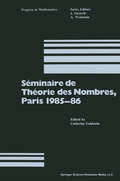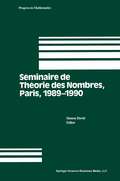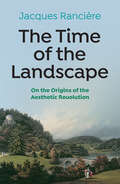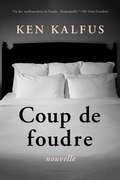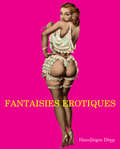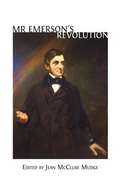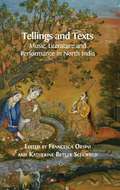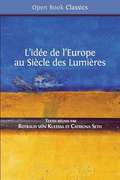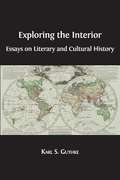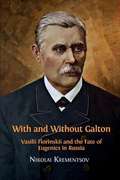- Table View
- List View
Séminaire de Théorie des Nombres, Paris 1985–86 (Progress in Mathematics #71)
by C. GoldsteinThis is the sixth annual volume of papers based on the outstanding lectures given at the Séminaire de Théorie des Nombres de Paris. The results presented in 1985-86 by an international group of mathematicians reflect the most recent work in many areas of number theory.
Seminaire de Theorie des Nombres, Paris 1989-1990 (Progress in Mathematics #102)
by D. SinnouLe travail ci-dessous developpe sur quelques points les tex:tes fondamentaux de C.L. Siegel [13[ et de K. Ramachandra [2). Remerclements C'est au Max Planck Institut de Bonn que la plus grande part des resultats (th. 2 et 3, ex:ception faite du point 3 d et th. 4 et 5) ont ete soit rectiges soit con~s. La rectaction definitive de ce travail a eu lieu ä l'Institut Fourier de Grenoble durant l'hiver 1990. Le th. 1 tel qu'il apparait ici, et le corollaire du th. 6 cf. identite (13), sont nouveaux. On trouvera une rectaction detailleedes th. 2 et 3 dans [51 et, parmi d'autres resultats, des th. 4, 5 et 6 dans [7). Que tous mes collegues et les deux equipes de secretartat recoivent ici mes remerciements les plus chaleureux. 2 1) On pose e( x) = e 1rix, x E C. Pour L un reseau complex:e, on note une base positivement olientee de L = lw + lw c'est-ä-dire teile que 1 2 On definit alors une forme modulaire .,.p> de poids 1 par 1](2)(w) ~fn (21l"i)ql/12 IJ ( - qn)2 1 { w2 n>l 1 12 q = e(W) , q 1 = e(W/12) , W = wt!w2 .
The Time of the Landscape: On the Origins of the Aesthetic Revolution
by Jacques RanciereThe time of the landscape is not the time when people started describing gardens, mountains and lakes in poems or representing them in works of art: it is the time when the landscape imposed itself as a specific object of thought. It is the time when both the harmony of arranged gardens and the disharmony of wild nature led to a revolution in the criteria of the beautiful and in the meaning of the word &“art.&” It coincided with the birth of aesthetics, understood as a regime for shaping how art is seen and thought, and also with the French Revolution, understood as a revolution in the very idea of what binds together a human community. The time of the landscape is the time when the conjunction of these two upheavals brought into focus, however hazily, a common horizon: that of a revolution that no longer concerns only the laws of the state or the norms of art, but the very forms of sensible experience. This brilliant and wide-ranging book will be of interest to students and scholars in philosophy, literature, the visual arts, and the humanities generally, and to anyone interested in critical theory and philosophy.
The Time of the Landscape: On the Origins of the Aesthetic Revolution
by Jacques RanciereThe time of the landscape is not the time when people started describing gardens, mountains and lakes in poems or representing them in works of art: it is the time when the landscape imposed itself as a specific object of thought. It is the time when both the harmony of arranged gardens and the disharmony of wild nature led to a revolution in the criteria of the beautiful and in the meaning of the word &“art.&” It coincided with the birth of aesthetics, understood as a regime for shaping how art is seen and thought, and also with the French Revolution, understood as a revolution in the very idea of what binds together a human community. The time of the landscape is the time when the conjunction of these two upheavals brought into focus, however hazily, a common horizon: that of a revolution that no longer concerns only the laws of the state or the norms of art, but the very forms of sensible experience. This brilliant and wide-ranging book will be of interest to students and scholars in philosophy, literature, the visual arts, and the humanities generally, and to anyone interested in critical theory and philosophy.
Coup de foudre: nouvelle
by Ken KalfusDans Coup de foudre, le célèbre auteur d'Un désordre américain (sélection 2006 du National Book Award), nous livre le genre d'œuvre explosive d'invention et de provocation littéraires que ses lecteurs attendent désormais de lui. Cette nouvelle provocatrice, d'actualité, est l'histoire tantôt farcesque, tantôt tragique, du président d'un établissement de prêt transnational accusé d'avoir violé une femme de chambre d'un hôtel new-yorkais. Evoquant l'actualité avec ironie et compassion, Kalfus jette un regard perçant sur les mécanismes politiques internationaux et l'hypocrisie des relations sexuelles.Mêlant intelligence, sens de l'humour distinctif et ambitions littéraires, Coup de foudre nous montre Kalfus en pleine possession de ses moyens.
Pre-Raphaelites: Beauty and Rebellion
by Christopher NewallFascinating new research into Pre-Raphaelite painters and collectors in Northern England positions Liverpool as the Victorian art capital of the north in Pre-Raphaelites: Beauty and Rebellion.This catalogue accompanies the first exhibition to examine Liverpool’s role in the history of the Pre-Raphaelite movement.The exhibition will be held at the Walker Art Gallery, Liverpool, from 12 February to 5 June 2016, and is being produced by National Museums Liverpool, working with the specialist art historian Christopher Newall, whose insightful essays will feature in the book.Containing new research on Pre-Raphaelite patrons and painters in Liverpool, including the collector John Miller and the artist John Ingle Lee, the book examines the relationship between artists like Ford Madox Brown and Rossetti with their Liverpool contemporaries, collectors, and the institutions that welcomed them, notably the forward-thinking Liverpool Academy. It will serve as an account of an important aspect of British artistic culture in the 19th century - and yet one for which there is no previous source of information.It will also feature approximately 100 works from the exhibition.
Fantasies Erotiques
by Hans-Jürgen DöppAu cours de ce voyage, nous rencontrerons une variété et une diversité de points de vue sur les mille métamorphoses de la sexualité. Elles nous montrent que rien n'est plus naturel que le désir sexuel, et qu'en même temps, rien n'est moins naturel que les formes sous lesquelles ce désir s'exprime et cherche son assouvissement. Cet ouvrage est une invitation à un voyage qui vous ouvrira le regard sur une géographie du plaisir.
Beyond Holy Russia: The Life And Times Of Stephen Graham
by Michael HughesThis biography of the travel writer and novelist Stephen Graham is learned, elegantly written and an original and important contribution to the scholarly literature on Anglo-Russian cultural relations, while also maintaining strong appeal for the general reader. [...] 'Beyond Holy Russia' provides a full and deeply considered account of the long and prolific life of Stephen Graham, alive to all its cultural, political and personal paradoxes. At the same time, it gives a rich portrait of English, Russian and American literary life in the first half of the twentieth century and beyond. — Rachel Polonsky This biography examines the long life of the traveller and author Stephen Graham. Graham walked across large parts of the Tsarist Empire in the years before 1917, describing his adventures in a series of books and articles that helped to shape attitudes towards Russia in Britain and the United States. In later years he travelled widely across Europe and North America, meeting some of the best known writers of the twentieth century, including H.G.Wells and Ernest Hemingway. Graham also wrote numerous novels and biographies that won him a wide readership on both sides of the Atlantic. This book traces Graham’s career as a world traveller, and provides a rich portrait of English, Russian and American literary life in the first half of the twentieth century. It also examines how many aspects of his life and writing coincide with contemporary concerns, including the development of New Age spirituality and the rise of environmental awareness. Beyond Holy Russia is based on extensive research in archives of private papers in Britain and the USA and on the many works of Graham himself. The author describes with admirable tact and clarity Graham’s heterodox and convoluted spiritual quest. The result is a fascinating portrait of a man who was for many years a significant literary figure on both sides of the Atlantic.
Yeats's Mask - Yeats Annual No. 19
by Margaret Harper Warwick GouldYeats’s Mask, Yeats Annual No. 19 is a special issue in this renowned research-level series. Fashionable in the age of Wilde, the Mask changes shape until it emerges as Mask in the system of A Vision. Chronologically tracing the concept through Yeats’s plays and those poems written as ‘texts for exposition’ of his occult thought which flowers in A Vision itself (1925 and 1937), the volume also spotlights ‘The Mask before The Mask’ numerous plays including Cathleen Ni-Houlihan, The King’s Threshold, Calvary, The Words upon the Window-pane, A Full Moon in March and The Death of Cuchulain. There are excurses into studies of Yeats’s friendship with the Oxford don and cleric, William Force Stead, his radio broadcasts, the Chinese contexts for his writing of ‘Lapis Lazuli’. His self-renewal after The Oxford Book of Modern Verse, and the key occult epistolary exchange ‘Leo Africanus’, edited from MSS by Steve L. Adams and George Mills Harper, is republished from the elusive Yeats Annual No. 1 (1982). The essays are by David Bradshaw, Michael Cade-Stewart, Aisling Carlin, Warwick Gould, Margaret Mills Harper, Pierre Longuenesse, Jerusha McCormack, Neil Mann, Emilie Morin, Elizabeth Müller and Alexandra Poulain, with shorter notes by Philip Bishop and Colin Smythe considering Yeats’s quatrain upon remaking himself and the pirate editions of The Land of Heart’s Desire. Ten reviews focus on various volumes of the Cornell Yeats MSS Series, his correspondence with George Yeats, and numerous critical studies. Yeats Annual is published by Open Book Publishers in association with the Institute of English Studies, University of London.
Mr. Emerson's Revolution
by Jean McClure MudgeThis volume traces the life, thought and work of Ralph Waldo Emerson, a giant of American intellectual history, whose transforming ideas greatly strengthened the two leading reform issues of his day: abolition and women’s rights. A broad and deep, yet cautious revolutionary, he spoke about a spectrum of inner and outer realities—personal, philosophical, theological and cultural—all of which gave his mid-career turn to political and social issues their immediate and lasting power. This multi-authored study frankly explores Emerson's private prejudices against blacks and women while he also publicly championed their causes. Such a juxtaposition freshly charts the evolution of Emerson's slow but steady application of his early neo-idealism to emancipating blacks and freeing women from social bondage. His shift from philosopher to active reformer had lasting effects not only in America but also abroad. In the U.S. Emerson influenced such diverse figures as Thoreau, Whitman, Dickinson and William James and in Europe Mickiewicz, Wilde, Kipling, Nietzsche, and Camus in Europe as well as many leading followers in India and Japan. The book includes over 170 illustrations, among them eight custom-made maps of Emerson's haunts and wide-ranging lecture itineraries as well as a new four-part chronology of his life placed alongside both national and international events as well as major inventions. Mr. Emerson's Revolution provides essential reading for students and teachers of American intellectual history, the abolitionist and women’s rights movement―and for anyone interested in the nineteenth-century roots of these seismic social changes.
Tellings and Texts: Music, Literature And Performance In North India
by Francesca Orsini Katherine Butler SchofieldExamining materials from early modern and contemporary North India and Pakistan, Tellings and Texts brings together seventeen first-rate papers on the relations between written and oral texts, their performance, and the musical traditions these performances have entailed. The contributions from some of the best scholars in the field cover a wide range of literary genres and social and cultural contexts across the region. The texts and practices are contextualized in relation to the broader social and political background in which they emerged, showing how religious affiliations, caste dynamics and political concerns played a role in shaping social identities as well as aesthetic sensibilities. By doing so this book sheds light into theoretical issues of more general significance, such as textual versus oral norms; the features of oral performance and improvisation; the role of the text in performance; the aesthetics and social dimension of performance; the significance of space in performance history and important considerations on repertoires of story-telling. The book also contains links to audio files of some of the works discussed in the text. Tellings and Texts is essential reading for anyone with an interest in South Asian culture and, more generally, in the theory and practice of oral literature, performance and story-telling.
Thomas Annan of Glasgow: Pioneer Of The Documentary Photograph
by Lionel GossmanIn the wake of Glasgow’s transformation in the nineteenth-century into an industrial powerhouse, the "Second City of the Empire,” a substantial part of the old town of Adam Smith degenerated into an overcrowded and disease-ridden slum. The Old Closes and Streets of Glasgow, Thomas Annan’s photographic record of this central section of the city prior to its demolition in accordance with the City of Glasgow Improvements Act of 1866, is widely recognized as a classic of nineteenth-century documentary photography. Annan’s achievement as a photographer of paintings and a portrait and landscape photographer is less widely known. Thomas Annan: Photographer of Victorian Scotland offers a handy, comprehensive and copiously illustrated overview of the full range of the photographer’s work. The book opens with a brief account of the immediate context of Annan’s career as a photographer: the astonishing florescence of photography in Victorian Scotland. Successive chapters deal with each of the main fields of his activity, touching along the way on issues such as the nineteenth-century debate over the status of photography — a mechanical practice or an artistic one? — and the still ongoing controversies surrounding the documentary photograph in particular. While the text itself is intended for the general reader, extensive endnotes amplify particular themes and offer guidance to readers interested in pursuing these themes further.
Vertical Readings in Dante's Comedy
by George Corbett Heather WebbVertical Readings in Dante’s Comedy is a reappraisal of the poem by an international team of thirty-four scholars. Each vertical reading analyses three same-numbered cantos from the three canticles: Inferno i, Purgatorio i and Paradiso i; Inferno ii, Purgatorio ii and Paradiso ii; etc. Although scholars have suggested before that there are correspondences between same-numbered cantos that beg to be explored, this is the first time that the approach has been pursued in a systematic fashion across the poem. This collection – to be issued in three volumes – offers an unprecedented repertoire of vertical readings for the whole poem. As the first volume exemplifies, vertical reading not only articulates unexamined connections between the three canticles but also unlocks engaging new ways to enter into core concerns of the poem. The three volumes thereby provide an indispensable resource for scholars, students and enthusiasts of Dante. The volume has its origin in a series of thirty-three public lectures held in Trinity College, the University of Cambridge (2012-2016) which can be accessed at the ‘Cambridge Vertical Readings in Dante’s Comedy’ website. This series would not have been possible without the generosity of certain sponsors: Trinity College; Selwyn College; the Italian Department, University of Cambridge; the Cambridge Italian Research Network (CIRN); the Centre for Medieval Literature (University of Southern Denmark and University of York); the University of Notre Dame; and the School of Languages, Cultures and Societies, University of Leeds.
Open Education: International Perspectives In Higher Education
by Patrick Blessinger Tj BlissThis insightful collection of essays explores the ways in which open education can democratise access to education for all. It is a rich resource that offers both research and case studies to relate the application of open technologies and approaches in education settings around the world. A must-read for practitioners, policy-makers, scholars and students in the field of education.
Human and Machine Consciousness
by David GamezConsciousness is widely perceived as one of the most fundamental, interesting and difficult problems of our time. However, we still know next to nothing about the relationship between consciousness and the brain and we can only speculate about the consciousness of animals and machines. Human and Machine Consciousness presents a new foundation for the scientific study of consciousness. It sets out a bold interpretation of consciousness that neutralizes the philosophical problems and explains how we can make scientific predictions about the consciousness of animals, brain-damaged patients and machines. Gamez interprets the scientific study of consciousness as a search for mathematical theories that map between measurements of consciousness and measurements of the physical world. We can use artificial intelligence to discover these theories and they could make accurate predictions about the consciousness of humans, animals and artificial systems. Human and Machine Consciousness also provides original insights into unusual conscious experiences, such as hallucinations, religious experiences and out-of-body states, and demonstrates how ‘designer’ states of consciousness could be created in the future. Gamez explains difficult concepts in a clear way that closely engages with scientific research. His punchy, concise prose is packed with vivid examples, making it suitable for the educated general reader as well as philosophers and scientists. Problems are brought to life in colourful illustrations and a helpful summary is given at the end of each chapter. The endnotes provide detailed discussions of individual points and full references to the scientific and philosophical literature.
Searching for Sharing: Heritage And Multimedia In Africa (World Oral Literature Ser. #Vol. 7)
by Daniela Merolla Mark TurinIn a world where new technologies are being developed at a dizzying pace, how can we best approach oral genres that represent heritage? Taking an innovative and interdisciplinary approach, this volume explores the idea of sharing as a model to construct and disseminate the knowledge of literary heritage with the people who are represented by and in it. Expert contributors interweave sociological analysis with an appraisal of the transformative impact of technology on literary and cultural production. Does technology restrict, constraining the experience of an oral performance, or does it afford new openings for different aesthetic experiences? Topics explored include the Mara Cultural Heritage Digital Library, the preservation of Ewe heritage material, new eresources for texts in Manding languages, and the possibilities of technauriture. This timely and necessary collection also examines to what extent digital documents can be and have been institutionalised in archives and museums, how digital heritage can remain free from co-option by hegemonic groups, and the roles that exist for community voices. A valuable contribution to a fast-developing field, this book is required reading for scholars and students in the fields of heritage, anthropology, linguistics, history and the emerging disciplines of multi-media documentation and analysis, as well as those working in the field of literature, folklore, and African studies. It is also important reading for museum and archive curators. The University of Leiden has generously contributed to the publication of this volume.
L’idée de l’Europe au Siècle des Lumières (PDF)
by Rotraud Von Kulessa Catriona SethFace aux défis – entre autres politiques – auxquels sont confrontés différents pays européens, les chercheurs dix-huitiémistes ont souhaité revenir sur des expressions anciennes de valeurs partagées et les interrogations passées sur des questions qui restent souvent d’actualité. Au Siècle des Lumières, nombre d’hommes et de femmes de lettres ont envisagé l’avenir du continent en particulier pour entériner leur souhait de garantir la paix en Europe. Les textes, réunis dans cette anthologie, et signés des grands écrivains du temps (Rousseau, Montesquieu, Voltaire, Kant, Hume ou encore Staël), comme d’oubliés de l’histoire, présentent, avec quelques excursus chronologiques (de Sully à Hugo) les réflexions de penseurs d’un dix-huitième siècle aux bornes chronologiques étendues – l’émergence et la chute de l’Empire engendrent des bouleversements nombreux –, sur l’Europe, son histoire, sa diversité, mais aussi sur ce qu’ont en commun les nations qui composent, dans leur variété, un ensemble géographique. Ils mettent en évidence les origines historiques d’un projet d’union européenne, le souhait de consolider les liens du continent avec le Maghreb ou la Turquie, l’importance accordée au commerce et les inquiétudes suscitées par les sursauts de l’histoire, mais aussi l’espoir placé dans les générations futures. La Société française d’étude du XVIIIe siècle, l’Université d’Augsburg, l’Université d’Oxford ont généreusement contribué à la publication de ce volume. In view of the challenges—many of which are political—that different European countries are currently facing, scholars who work on the 18th century have compiled this anthology which includes earlier recognitions of common values and past considerations of questions which often remain pertinent nowadays. During the Enlightenment, many men and women of letters envisaged the continent’s future in particular when stressing their hope that peace could be secured in Europe. The texts gathered here, and signed by major thinkers of the time (Rousseau, Montesquieu, Voltaire, Kant, Hume or Staël for instance), as well as by writers history has forgotten, present the reflections, with a couple of chronological extensions (from Sully to Victor Hugo) of authors from the long eighteenth century—the French Empire and the fall of Napoleon generated numerous upheavals—on Europe, its history, its diversity, but also on what the nations, which, in all their diversity, make up a geographical unit, have in common. They show the historical origins of the project of a European union, the desire to consolidate the continent’s ties to the Maghreb or to Turkey, the importance granted to commerce and the worries engendered by history’s convulsions, but also the hope vested in future generations.
L’idée de l’Europe au Siècle des Lumières
by Rotraud Von Kulessa Et Catriona SethFace aux défis – entre autres politiques – auxquels sont confrontés différents pays européens, les chercheurs dix-huitiémistes ont souhaité revenir sur des expressions anciennes de valeurs partagées et les interrogations passées sur des questions qui restent souvent d’actualité. Au Siècle des Lumières, nombre d’hommes et de femmes de lettres ont envisagé l’avenir du continent en particulier pour entériner leur souhait de garantir la paix en Europe. Les textes, réunis dans cette anthologie, et signés des grands écrivains du temps (Rousseau, Montesquieu, Voltaire, Kant, Hume ou encore Staël), comme d’oubliés de l’histoire, présentent, avec quelques excursus chronologiques (de Sully à Hugo) les réflexions de penseurs d’un dix-huitième siècle aux bornes chronologiques étendues – l’émergence et la chute de l’Empire engendrent des bouleversements nombreux –, sur l’Europe, son histoire, sa diversité, mais aussi sur ce qu’ont en commun les nations qui composent, dans leur variété, un ensemble géographique. Ils mettent en évidence les origines historiques d’un projet d’union européenne, le souhait de consolider les liens du continent avec le Maghreb ou la Turquie, l’importance accordée au commerce et les inquiétudes suscitées par les sursauts de l’histoire, mais aussi l’espoir placé dans les générations futures. La Société française d’étude du XVIIIe siècle, l’Université d’Augsburg, l’Université d’Oxford ont généreusement contribué à la publication de ce volume. In view of the challenges—many of which are political—that different European countries are currently facing, scholars who work on the 18th century have compiled this anthology which includes earlier recognitions of common values and past considerations of questions which often remain pertinent nowadays. During the Enlightenment, many men and women of letters envisaged the continent’s future in particular when stressing their hope that peace could be secured in Europe. The texts gathered here, and signed by major thinkers of the time (Rousseau, Montesquieu, Voltaire, Kant, Hume or Staël for instance), as well as by writers history has forgotten, present the reflections, with a couple of chronological extensions (from Sully to Victor Hugo) of authors from the long eighteenth century—the French Empire and the fall of Napoleon generated numerous upheavals—on Europe, its history, its diversity, but also on what the nations, which, in all their diversity, make up a geographical unit, have in common. They show the historical origins of the project of a European union, the desire to consolidate the continent’s ties to the Maghreb or to Turkey, the importance granted to commerce and the worries engendered by history’s convulsions, but also the hope vested in future generations. The Société française d’étude du XVIIIe siècle, Augsburg University and the University of Oxford have generously contributed towards the publication of this volume.
Vertical Readings in Dante's Comedy: Volume 3
by George Corbett Heather WebbVertical Readings in Dante’s Comedy is a reappraisal of the poem by an international team of thirty-four scholars. Each vertical reading analyses three same-numbered cantos from the three canticles: Inferno i, Purgatorio i and Paradiso i; Inferno ii, Purgatorio ii and Paradiso ii; etc. Although scholars have suggested before that there are correspondences between same-numbered cantos that beg to be explored, this is the first time that the approach has been pursued in a systematic fashion across the poem. This collection in three volumes offers an unprecedented repertoire of vertical readings for the whole poem. As the first volume exemplifies, vertical reading not only articulates unexamined connections between the three canticles but also unlocks engaging new ways to enter into core concerns of the poem. The three volumes thereby provide an indispensable resource for scholars, students and enthusiasts of Dante. The volume has its origin in a series of thirty-three public lectures held in Trinity College, the University of Cambridge (2012-2016) which can be accessed at the Cambridge Vertical Readings in Dante’s Comedy website.
The Idea of Europe: Enlightenment Perspectives (Open Book Classics Ser. #Vol. 7)
by Catriona Seth Rotraud Von KulessaIn view of the challenges—many of which are political—that different European countries are currently facing, scholars who work on the eighteenth century have compiled this anthology which includes earlier recognitions of common values and past considerations of questions which often remain pertinent nowadays. During the Enlightenment, many men and women of letters envisaged the continent’s future in particular when stressing their hope that peace could be secured in Europe. The texts gathered here, and signed by major thinkers of the time (Rousseau, Montesquieu, Voltaire, Kant, Hume or Staël for instance), as well as by writers history has forgotten, present the reflections, with a couple of chronological extensions (from Sully to Victor Hugo) of authors from the long eighteenth century—the French Empire and the fall of Napoleon generated numerous upheavals—on Europe, its history, its diversity, but also on what the nations, which, in all their diversity, make up a geographical unit, have in common. They show the historical origins of the project of a European union, the desire to consolidate the continent’s ties to the Maghreb or to Turkey, the importance granted to commerce and the worries engendered by history’s convulsions, but also the hope vested in future generations. The Idea of Europe follows its sister edition in French, L’idée de l’Europe au Siècle des Lumières, also published by Open Book. The Société française d’étude du XVIIIe siècle, Augsburg University and the University of Oxford have generously contributed towards the publication of this volume.
Exploring the Interior: Essays On Literary And Cultural History
by Karl S. GuthkeIn this fascinating collection of essays Harvard Emeritus Professor Karl S. Guthke examines the ways in which, for European scholars and writers of the eighteenth and early nineteenth century, world-wide geographical exploration led to an exploration of the self. Guthke explains how in the age of Enlightenment and beyond intellectual developments were fuelled by excitement about what Ulrich Im Hof called "the grand opening-up of the wide world”, especially of the interior of the non-European continents. This outward turn was complemented by a fascination with "the world within” as anthropology and ethnology focused on the humanity of the indigenous populations of far-away lands – an interest in human nature that suggested a way for Europeans to understand themselves, encapsulated in Gauguin’s Tahitian rumination "What are we?” The essays in the first half of the book discuss first- or second-hand, physical or mental encounters with the exotic lands and populations beyond the supposed cradle of civilisation. The works of literature and documents of cultural life featured in these essays bear testimony to the crossing not only of geographical, ethnological, and cultural borders but also of borders of a variety of intellectual activities and interests. The second section examines the growing interest in astronomy and the engagement with imagined worlds in the universe, again with a view to understanding homo sapiens, as compared now to the extra-terrestrials that were confidently assumed to exist. The final group of essays focuses on the exploration of the landscape of what was called "the universe within”; featuring, among a variety of other texts, Schiller’s plays The Maid of Orleans and William Tell, these essays observe and analyse what Erich Heller termed "The Artist’s Journey into the Interior.” This collection, which travels from the interior of continents to the interior of the mind, is itself a set of explorations that revel in the discovery of what was half-hidden in language. Written by a scholar of international repute, it is eye-opening reading for all those with an interest in the literary and cultural history of (and since) the Enlightenment.
Die Europaidee im Zeitalter der Aufklärung
by Rotraud von Kulessa und Catriona SethAngesichts der aktuellen Herausforderungen – nicht zuletzt politischer Natur – mit denen sich viele europäische Staaten konfrontiert sehen, haben sich die Aufklärungsforscher entschlossen, auf die Geschichte der Europaidee zurückzukommen. Bereits im 18. Jahrhundert und zuvor besann man sich auf gemeinsame Werte und eine gemeinsame Geschichte; die damals gestellten Fragen ähneln in vielen Bereichen den heutigen. Die Autoren und Philosophen der Aufklärung haben so bereits über die Möglichkeiten einer europäischen Einigung zwecks Sicherung des Friedens auf dem Kontinent nachgedacht. Die Texte der vorliegenden Anthologie, verfasst sowohl von den großen Denkern der Zeit (Rousseau, Montesquieu, Voltaire, Kant, Hume oder Germaine de Staël) wie auch von weniger bekannten oder gar in Vergessenheit geratenen, präsentieren, mit einigen chronologischen Exkursen (von Sully bis Victor Hugo), die Ideen der Denker eines weit gefassten 18. Jahrhunderts zu Europa, seiner Geschichte, seiner Vielfalt, aber auch zu den Gemeinsamkeiten der Nationen, die trotz ihrer Vielfalt eine geographische Einheit bilden. Die Texte zeigen uns so die historischen Ursprünge des Projektes der europäischen Einigung, erörtern die Vorteile einer assoziierten Türkei und einer Einbindung des Maghreb sowie die Bedeutung des europäischen Handels. Sie verweisen auch auf die durch die historischen Unruhen verursachten Ängste wie auch auf die Zukunftsperspektiven eines vereinten Europas. Das Buch wurde mit Unterstützung der Universitäten Augsburg, Oxford sowie der Société française d’étude du XVIIIe siècle gedruckt. In view of the challenges—many of which are political—that different European countries are currently facing, scholars who work on the 18th century have compiled this anthology which includes earlier recognitions of common values and past considerations of questions which often remain pertinent nowadays. During the Enlightenment, many men and women of letters envisaged the continent’s future in particular when stressing their hope that peace could be secured in Europe. The texts gathered here, and signed by major thinkers of the time (Rousseau, Montesquieu, Voltaire, Kant, Hume or Staël for instance), as well as by writers history has forgotten, present the reflections, with a couple of chronological extensions (from Sully to Victor Hugo) of authors from the long eighteenth century—the French Empire and the fall of Napoleon generated numerous upheavals—on Europe, its history, its diversity, but also on what the nations, which, in all their diversity, make up a geographical unit, have in common. They show the historical origins of the project of a European union, the desire to consolidate the continent’s ties to the Maghreb or to Turkey, the importance granted to commerce and the worries engendered by history’s convulsions, but also the hope vested in future generations. The Société française d’étude du XVIIIe siècle, Augsburg University and the University of Oxford have generously contributed towards the publication of this volume.
With and Without Galton: Vasilii Florinskii And The Fate Of Eugenics In Russia
by Nikolai KrementsovIn 1865, British polymath Francis Galton published his initial thoughts about the scientific field that would become ‘eugenics.’ The same year, Russian physician Vasilii Florinskii addressed similar issues in a sizeable treatise, entitled Human Perfection and Degeneration. Initially unheralded, Florinskii’s book would go on to have a remarkable afterlife in twentieth- and twenty-first-century Russia. In this lucid and insightful work, Nikolai Krementsov argues that the concept of eugenics brings together ideas, values, practices, and fears energised by a focus on the future. It has proven so seductive to different groups over time because it provides a way to grapple with fundamental existential questions of human nature and destiny. With and Without Galton develops this argument by tracing the life-story of Florinskii’s monograph from its uncelebrated arrival amid the Russian empire’s Great Reforms, to its reissue after the Bolshevik Revolution, its decline under Stalinism, and its subsequent resurgence: first, as a founding document of medical genetics, and most recently, as a manifesto for nationalists and racial purists. Krementsov’s meticulously researched ‘biography of a book’ sheds light not only on the peculiar fate of eugenics in Russia, but also on its convoluted transnational history, elucidating the field’s protean nature and its continuing and contested appeal to diverse audiences, multiple local trajectories, and global trends. It is required reading for historians of eugenics, science, medicine, education, literature, and Russia, and it will also appeal to the general reader looking for a deeper understanding of this challenging subject. Victoria College, University of Toronto, has generously contributed to the publication of this volume.
Life Histories of Etnos Theory in Russia and Beyond
by David G. Anderson Dmitry V. Arzyutov Sergei S. AlymovThe idea of etnos came into being over a hundred years ago as a way of understanding the collective identities of people with a common language and shared traditions. In the twentieth century, the concept came to be associated with Soviet state-building, and it fell sharply out of favour. Yet outside the academy, etnos-style arguments not only persist, but are a vibrant part of regional anthropological traditions. Life Histories of Etnos Theory in Russia and Beyond makes a powerful argument for reconsidering the importance of etnos in our understanding of ethnicity and national identity across Eurasia. The collection brings to life a rich archive of previously unpublished letters, fieldnotes, and photographic collections of the theory’s early proponents. Using contemporary fieldwork and case studies, the volume shows how the ideas of these ethnographers continue to impact and shape identities in various regional theatres from Ukraine to the Russian North to the Manchurian steppes of what is now China. Through writing a life history of these collectivist concepts, the contributors to this volume unveil a world where the assumptions of liberal individualism do not hold. In doing so, they demonstrate how notions of belonging are not fleeting but persistent, multi-generational, and bio-social.
The Red Countess: Select Autobiographical and Fictional Writing of Hermynia Zur Mühlen (1883-1951)
by Hermynia Mühlen Lionel GossmanBorn into a distinguished aristocratic family of the old Habsburg Empire, Hermynia Zur Mühlen spent much of her childhood and early youth travelling in Europe and North Africa with her diplomat father. Never comfortable with the traditional roles women were expected to play, she broke as a young adult both with her family and, after five years on his estate in the old Czarist Russia, with her German Junker husband, and set out as an independent, free-thinking individual, earning a precarious living as a writer. She translated over 70 books from English, French and Russian into German, notably the novels of Upton Sinclair, which she turned into best-sellers in Germany; produced a series of detective novels under a pseudonym; wrote seven engaging and thought-provoking novels of her own, six of which were translated into English; contributed countless insightful short stories and articles to newspapers and magazines; and, having become a committed socialist, achieved international renown in the 1920s with her Fairy Tales for Workers’ Children, which were widely translated including into Chinese and Japanese. Because of her fervent and outspoken opposition to National Socialism, she and her life-long Jewish partner, Stefan Klein, had to flee first Germany, where they had settled, and then, in 1938, her native Austria. They found refuge in England, where Zur Mühlen died, forgotten and virtually penniless, in 1951. This new, expanded edition contains: Zur Mühlen’s autobiographical memoir, The End and the Beginning; The editor’s detailed notes on the persons and events mentioned in the autobiography; A selection of Zur Mühlen’s short stories and two fairy tales; A synopsis of Zur Mühlen’s untranslated novel Our Daughters the Nazi Girls; An essay by the Editor on Zur Mühlen’s life and work; A bibliography of Zur Mühlen’s novels in English translation; A portfolio of selected illustrations of her work by George Grosz and Heinrich Vogeler; A free online supplement with additional original material
